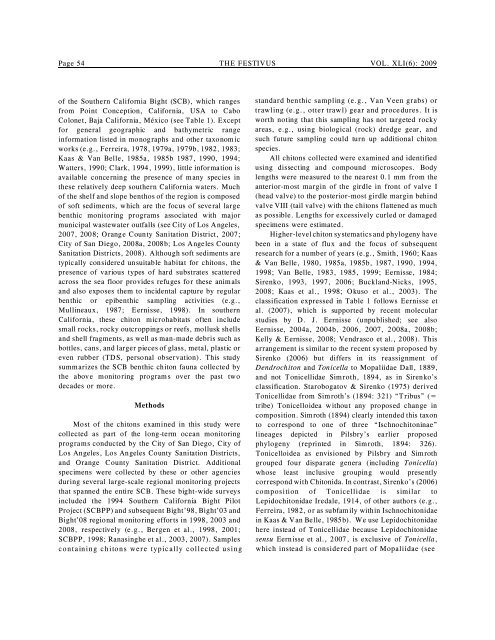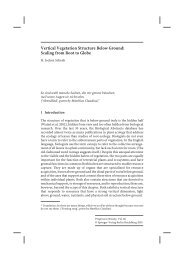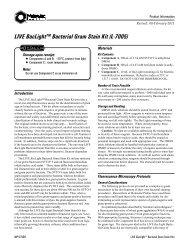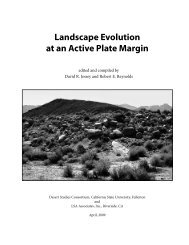Chitons (Mollusca: Polyplacophora) - Biological Science - California ...
Chitons (Mollusca: Polyplacophora) - Biological Science - California ...
Chitons (Mollusca: Polyplacophora) - Biological Science - California ...
Create successful ePaper yourself
Turn your PDF publications into a flip-book with our unique Google optimized e-Paper software.
Page 54 THE FESTIVUS VOL. XLI(6): 2009<br />
of the Southern <strong>California</strong> Bight (SCB), which ranges<br />
from Point Conception, <strong>California</strong>, USA to Cabo<br />
Colonet, Baja <strong>California</strong>, México (see Table 1). Except<br />
for general geographic and bathymetric range<br />
information listed in monographs and other taxonomic<br />
works (e.g., Ferreira, 1978, 1979a, 1979b, 1982, 1983;<br />
Kaas & Van Belle, 1985a, 1985b 1987, 1990, 1994;<br />
Watters, 1990; Clark, 1994, 1999), little information is<br />
available concerning the presence of many species in<br />
these relatively deep southern <strong>California</strong> waters. Much<br />
of the shelf and slope benthos of the region is composed<br />
of soft sediments, which are the focus of several large<br />
benthic monitoring programs associated with major<br />
municipal wastewater outfalls (see City of Los Angeles,<br />
2007, 2008; Orange County Sanitation District, 2007;<br />
City of San Diego, 2008a, 2008b; Los Angeles County<br />
Sanitation Districts, 2008). Although soft sediments are<br />
typically considered unsuitable habitat for chitons, the<br />
presence of various types of hard substrates scattered<br />
across the sea floor provides refuges for these animals<br />
and also exposes them to incidental capture by regular<br />
benthic or epibenthic sampling activities (e.g.,<br />
Mullineaux, 1987; Eernisse, 1998). In southern<br />
<strong>California</strong>, these chiton microhabitats often include<br />
small rocks, rocky outcroppings or reefs, mollusk shells<br />
and shell fragments, as well as man-made debris such as<br />
bottles, cans, and larger pieces of glass, metal, plastic or<br />
even rubber (TDS, personal observation). This study<br />
summarizes the SCB benthic chiton fauna collected by<br />
the above monitoring programs over the past two<br />
decades or more.<br />
Methods<br />
Most of the chitons examined in this study were<br />
collected as part of the long-term ocean monitoring<br />
programs conducted by the City of San Diego, City of<br />
Los Angeles, Los Angeles County Sanitation Districts,<br />
and Orange County Sanitation District. Additional<br />
specimens were collected by these or other agencies<br />
during several large-scale regional monitoring projects<br />
that spanned the entire SCB. These bight-wide surveys<br />
included the 1994 Southern <strong>California</strong> Bight Pilot<br />
Project (SCBPP) and subsequent Bight’98, Bight’03 and<br />
Bight’08 regional monitoring efforts in 1998, 2003 and<br />
2008, respectively (e.g., Bergen et al., 1998, 2001;<br />
SCBPP, 1998; Ranasinghe et al., 2003, 2007). Samples<br />
containing chitons were typically collected using<br />
standard benthic sampling (e.g., Van Veen grabs) or<br />
trawling (e.g., otter trawl) gear and procedures. It is<br />
worth noting that this sampling has not targeted rocky<br />
areas, e.g., using biological (rock) dredge gear, and<br />
such future sampling could turn up additional chiton<br />
species.<br />
All chitons collected were examined and identified<br />
using dissecting and compound microscopes. Body<br />
lengths were measured to the nearest 0.1 mm from the<br />
anterior-most margin of the girdle in front of valve I<br />
(head valve) to the posterior-most girdle margin behind<br />
valve VIII (tail valve) with the chitons flattened as much<br />
as possible. Lengths for excessively curled or damaged<br />
specimens were estimated.<br />
Higher-level chiton systematics and phylogeny have<br />
been in a state of flux and the focus of subsequent<br />
research for a number of years (e.g., Smith, 1960; Kaas<br />
& Van Belle, 1980, 1985a, 1985b, 1987, 1990, 1994,<br />
1998; Van Belle, 1983, 1985, 1999; Eernisse, 1984;<br />
Sirenko, 1993, 1997, 2006; Buckland-Nicks, 1995,<br />
2008; Kaas et al., 1998; Okuso et al., 2003). The<br />
classification expressed in Table 1 follows Eernisse et<br />
al. (2007), which is supported by recent molecular<br />
studies by D. J. Eernisse (unpublished; see also<br />
Eernisse, 2004a, 2004b, 2006, 2007, 2008a, 2008b;<br />
Kelly & Eernisse, 2008; Vendrasco et al., 2008). This<br />
arrangement is similar to the recent system proposed by<br />
Sirenko (2006) but differs in its reassignment of<br />
Dendrochiton and Tonicella to Mopaliidae Dall, 1889,<br />
and not Tonicellidae Simroth, 1894, as in Sirenko’s<br />
classification. Starobogatov & Sirenko (1975) derived<br />
Tonicellidae from Simroth’s (1894: 321) “Tribus” (=<br />
tribe) Tonicelloidea without any proposed change in<br />
composition. Simroth (1894) clearly intended this taxon<br />
to correspond to one of three “Ischnochitoninae”<br />
lineages depicted in Pilsbry’s earlier proposed<br />
phylogeny (reprinted in Simroth, 1894: 326).<br />
Tonicelloidea as envisioned by Pilsbry and Simroth<br />
grouped four disparate genera (including Tonicella)<br />
whose least inclusive grouping would presently<br />
correspond with Chitonida. In contrast, Sirenko’s (2006)<br />
composition of Tonicellidae is similar to<br />
Lepidochitonidae Iredale, 1914, of other authors (e.g.,<br />
Ferreira, 1982, or as subfamily within Ischnochitonidae<br />
in Kaas & Van Belle, 1985b). We use Lepidochitonidae<br />
here instead of Tonicellidae because Lepidochitonidae<br />
sensu Eernisse et al., 2007, is exclusive of Tonicella,<br />
which instead is considered part of Mopaliidae (see
















